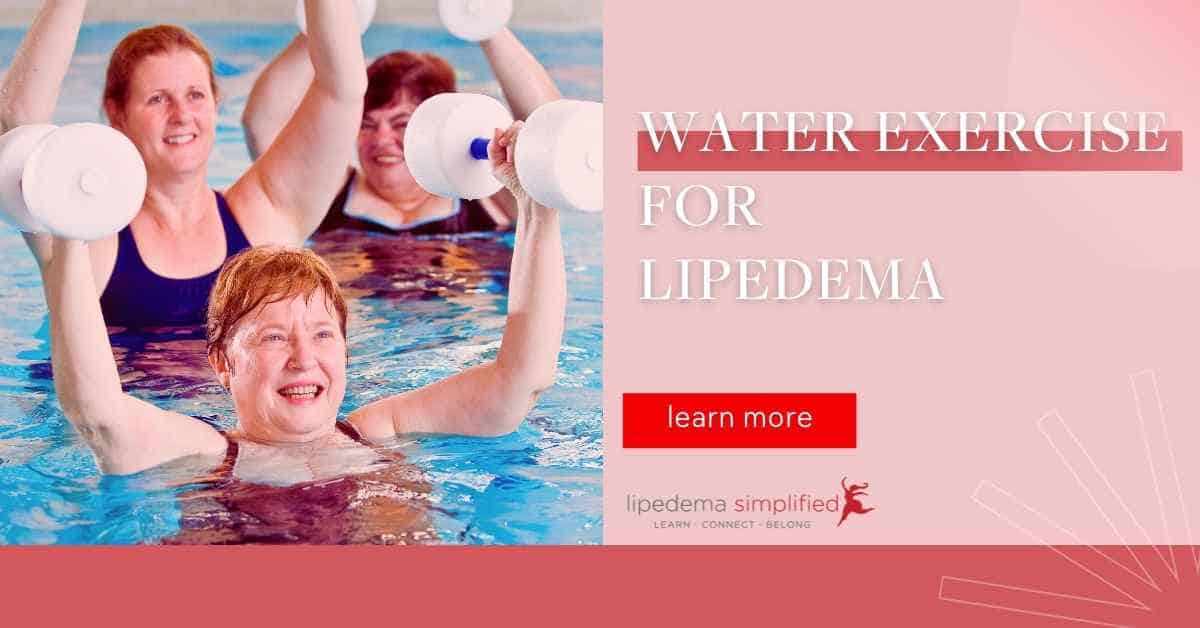
Perhaps the most effective, and consequently the most enjoyable exercise that targets the lymphatics and symptoms of lipedema is movement that is performed in the water. This gentle, non-impact type of exercise is especially useful for someone who may be deconditioned, in pain, or have reduced mobility, as may be the case for someone with lipedema. Additionally, if you are submerged to your chest or even to your neck, this means that almost your entire body is reaping the physiological effects of immersion in water. Although most research examining water exercise and lymphatic functioning has been performed with breast cancer survivors, several other studies showed the benefits for lower body swelling and lipedema as well. 1 2 3 Study outcomes included reduced swelling, improved cardiovascular function, and reduced fatigue among other positive results.
What are its advantages?
The specific properties of water that make exercising while submerged more advantageous over land-based activities include hydrostatic pressure, immersion diuresis, buoyancy, and viscosity.
Hydrostatic Pressure and Immersion Diuresis
The effect of hydrostatic pressure creates a pressure gradient in which pressure increases with deeper immersion. If you are standing in the water, your feet are submerged the deepest and will have more compression. The compression gradually decreases toward the surface of the water. As much as 600 milliliters of fluid can be moved out of the legs if you are submerged to your chest. 4 This property of water means that compression garments are not necessary while exercising in the water.
The fluid displacement from the legs up to the trunk due to hydrostatic pressure also has a direct impact on what scuba divers call immersion diuresis or the increased urine production that occurs when a portion of our body is submerged underwater. The need to urinate soon after exiting the pool is certainly satisfying to someone with fluid retention or a lymphatic disorder. This occurs due to the release of a hormone called atrial natriuretic peptide, or ANP, in response to the increased fluid volume moving to the heart. This hormone lowers blood pressure by stimulating the kidneys to release water. 5 Interestingly, ANP also increases ketone production, which we know helps with burning our body fat. 6
Buoyancy
Buoyancy is the tendency to float due to the support of the water pushing up against gravity. This property of water supports large heavy limbs and allows a much greater pain-free range of motion than can ever be experienced on land. This may allow for better posture and improved gait and, most likely, decreased pain. Exercise can be more pleasurable when there is less weight-bearing and stress on joints. Further, if there is a gait disturbance due to large body size or asymmetry of limbs, exercise on land may contribute to further injury or damage. This can be avoided by instead moving in the water.
Water Viscosity
Water viscosity, or the thickness of water, allows us to grade exercise appropriate to each person. Using the resistance of water and its turbulence effects, you can make your exercise gentle or vigorous. The faster you move through the water, the more resistance you will feel, and thus can exercise harder if desired. 4 Water viscosity also has the ability to enhance the muscle-joint pump and facilitate lymph transport. 3
What are some barriers?
There are some disadvantages to water exercise that may prove to be a barrier to participation. Social embarrassment due to poor body image can be an issue for some when donning a bathing suit and entering a public pool. Availability of a nearby pool and accommodations for disabled access may not be an option in your community. Finally, some medical conditions, the presence of an open wound, or incontinence would prevent pool use.
Despite these potential barriers, many women find exercising in the water to be the best option for increasing their physical activity and managing lipedema.
~ Leslyn Keith, OTD, CLT-LANA
Board President, Director of Research | The Lipedema Project
Water Exercise & Lipedema (an excerpt from The Lymphatic Code by Leslyn Keith, OTD, CLT-LANA)
Citations
- Burger et al. (2019) Effect of aqua-cycling as exercise therapy in the diagnosis of lipedema. Phlebologie, 48(03): 182-186. DOI: 10.1055/a-0839-6346
- Gianesini et al. (2017) A specifically designed aquatic exercise protocol to reduce chronic lower limb edema. Phlebology, 32(9): 594-600. doi: 10.1177/0268355516673539.
- Tidhar et al. (2007) Aqua lymphatic therapy in managing lower extremity lymphedema. J Support Oncol. 5(4):179-83.
- Bruce E. Becker (2009) Aquatic Therapy: Scientific Foundations and Clinical Rehabilitation Applications, PM&R, 1(9): 859-872. doi.org/10.1016/j.pmrj.2009.05.017
- Wilcock et al. (2006) Physiological Response to Water Immersion. Sports Med, 36, 747–765. doi.org/10.2165/00007256-200636090-00003
- Birkenfeld et al. (2005) Lipid Mobilization with Physiological Atrial Natriuretic Peptide Concentrations in Humans, The Journal of Clinical Endocrinology & Metabolism, 90(6): 3622–3628. doi.org/10.1210/jc.2004-1953
